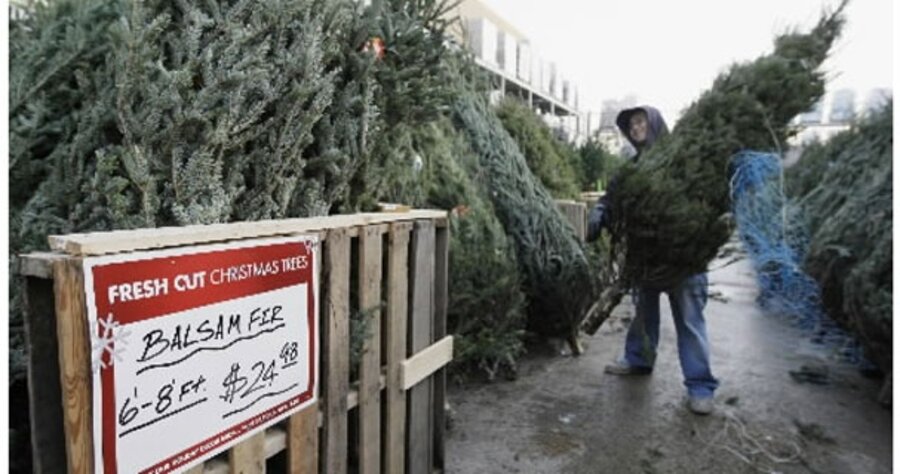'Tis the season for Christmas trees
Loading...
| Chicago
As Christmas traditions go, this one’s big.
Every year, the Proeber family traipses through the fields of central Illinois searching for the perfect Christmas tree before breaking out the saw, tying their selection to the roof of their car and hauling it back to their living room.
“It would be a whole day’s worth of celebration, a whole day of entertainment,” said Jan Proeber, a minister from Lexington, Ill. “You smelled Christmas and you tasted Christmas and you felt Christmas.”
But such rituals — cemented for many in the collective American memory thanks to Currier & Ives and Norman Rockwell and, yes, even Chevy Chase — may be fading.
Last year, 16 percent of the nation’s 31.3 million live Christmas trees were cut by the people whose family rooms they’d grace, according to industry data. A larger percentage, roughly one in four, were bought at big-box chains.
The segment’s Christmas tree business has been steadily growing, overtaking sales from cut-it-yourself farms last year while continually overpowering tree-selling venues such as nurseries, retail lots, and nonprofit groups, according to the National Christmas Tree Association.
The Home Depot Inc., the nation’s largest retailer of fresh-cut trees, expects to sell about 2 million trees between Thanksgiving and Christmas during a carefully choreographed sales extravaganza.
The production, which began Monday when the company’s stores around the nation started to receive shipments of trees from two dozen farms, is so detailed that the Atlanta-based company knows just where to send tall trees (wealthier suburban communities where homes are more likely to have been designed with cathedral ceilings) and what varieties sell better in certain regions (balsam firs in the northern US; noble firs in the West.)
Close behind Home Depot are household names like Wal-Mart Stores Inc. and Lowe’s Cos. Inc.
Despite the growth of big business in the Christmas tree market, there are still families hanging on to over-the-river-and-through-the-woods moments.
In the early 1990s, the Huron-Manistee National Forests in northern Michigan sold more than 600 permits each year to people willing to pay a few dollars to get permission to cut their own tree.
In the nearly two decades since, families began going elsewhere, caught up in the buy-it-now phenomenon of the nation.
“Christmas trees were cheaper and it was easy for people to go out and buy them,” said Carol Nilsson, public information specialist with the forest. “But there were always the people who wanted the Christmas experience of going out and finding them.”
Last year, 149 people bought the $5 permits that entitled them to a map of the forest and up to three trees. But interest in the program is up this year, and officials expect more people to trudge along the forest’s trails to look for a tree — a trend Ms. Nilsson and others attribute to the recession.
“Trees, when you look at them in the wild, they look very different,” Nilsson said. “But to cut it down and drag it back out and put it in your car, it’s unique. And it’s a unique tree when you put it in your house. It’s not pruned and it’s not painted.”
At the Santa Cruz Host Lions Club in California, officers expect their Christmas tree-selling business to be slower than usual when they open shop Friday in a parking lot.
Last year, the group wound up mulching 200 unsold trees, and this year cut orders to 800, down from the 1,200 to 1,400 trees it typically stocks. The club, which has sold trees for more than four decades, also halved its order for the tallest trees.
Linda Alameda, who runs the club’s Christmas tree lot, said some shoppers are switching to artificial trees, while others are just simply scaling back to save money. And still more are heading to stores like Wal-Mart.
“I think people tend to go there just because they know where they’re at,” she said. “People probably go because they’re familiar with them, and I’m guessing they’re cheaper because they can get them by bulk and a lot cheaper than we can.”
Home Depot said its average tree, while depending on factors like market and size, sells for about $30 and is usually between six and seven feet tall. The Lions Club in Santa Cruz said it sells small tabletop trees for about $24 and has 11-foot to 12-foot trees that can be about $200.
At Home Depot’s 2,000 US. stores, it’s a revamped kind of Christmas tradition that’s taking hold.
Employees go through training seminars about how to help customers pick trees and how to safely tie them to roofs. And workers in the garden department are joined by a slew of volunteers from other areas of the store who want the opportunity to get a jump-start on the Christmas season.
“They get in the holiday spirit,” said Don Blume, Home Depot’s divisional merchandise manager. “They love to help set it up and help the consumers picking out the tree and help with loading.”
'Tis the season, indeed.
Christmas tree facts and figures
Where trees were bought (2007):
—Chain store: 23 percent
—Choose and harvest farm: 21 percent
—Nursery/garden center: 20 percent
—Retail lot: 12 percent
—Nonprofit group: 9 percent
—Other: 15 percent
Real versus fake? (2007):
—Real: 31.3 million
—Fake: 17.4 million.
Real versus fake? (2001):
—Real: 27.8 million.
—Fake: 7.3 million.
Source: National Christmas Tree Association





